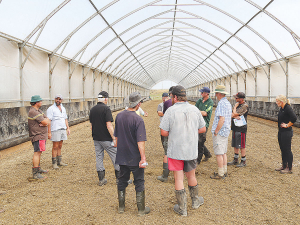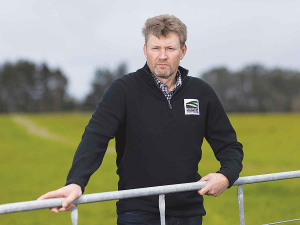He installed a 120 x 12m plastic feed pad on his farm at the tiny settlement of Kuku, between the townships of Levin and Otaki. He milks 280 cows which produce about 120,000 kgMS on the 135ha effective farm. Kuku Farms is on the western side of State Highway 1 where the soils are 50/50 mix of peat and sand. Agar also owns a slightly larger dairy farm close to Otaki.
The feed pad is an imposing sight, situated on flat land about 200 metres from the actual dairy shed, which is located on a hill above the covered feed pad. The structure resembles a large glass house with a roof and sides and, yes, it gets hot during the summer days. Down each side of the feed pad is a continuous trough into which is fed the maize silage.
But Agar says it is strictly a feed pad and not a stand-off pad.
"In our case, the cows are only on the feed pad for about three quarters of an hour before the two milkings," he told Dairy News.
"Most stand-off pads, the cows can be there for 20 hours a day. Because in our case the cows are only there for a short time, we have allocated them just four square metres of space. If it was a stand-off pad it would need to be four times the size," he says.
The system is designed to minimise milking time. All the gates on the property are automatic and open at about 4am, then cows make their own way to the shed. Waiting for them is a ration of about 5kg of maize silge. This is actually put in the troughts before the afternoon milking on the previous day and Rod Agar says there is sufficient feed for two milkings.
After the cows have tucked into the maize silage for about half an hour, they are let our and make their way to the dairy shed. Agar says it only took about five days for the cows to get used to the system, which he says works 99% of the time.
"One of the benefits is that staff don't have to get up so early to bring the cows in.
"The other advantage is that the night paddocks around the shed to bring the cows, in but with the cows bringing themselves in, you can use whatever paddocks, wherever you want," he says.
The story about the plastic feed pad was told at a recent DairyNZ discussion group meeting on the farm, attended by about twenty local farmers and rural professionals who were shown the building and had the opportunity to ask questions about it.
Agar says he got the idea of the feed pad after reading an article in a farming magazine and started making inquiries about what other farmers were doing around the country.
He made contact with a dairy farmer in Ruakākā in Northland who built a similar plastic house over his existing concrete feed pad.
"While we liked the concept, we were trying to get away from concrete and get away from water because its water in these feed pads, be it rain or wash-down water, that carries the manure that is problem," he says.
So after talking to a number of consultants, Agar came up with a diffferent solution.
He put down a layer of sand and on it a continuous layer of plastic with a vee in the middle. On the plastic sits a drainage pipe and over that a further 200mm of sand to protect the plastic.
On top of all that is about another 400mm of coarse wood chips and fence post peelings which form a matting designed to absorb the urine and manure.
"The drain is connected to a storage tank but in reality there is nothing in it because the woodchips absorb the urine. The floor of the shed is dry so there is no need to turn it over or remove it anytime soon. We believe this could last for up to five years before we need to replace the woodchip," says Agar.
He does admit to one challenge with the shed which was evident at the field day - the heat inside the shed during the hot summer. Agar says they are looking at replacing some of the plastic panels with shade cloth to let in more air and reduce heat stress for cows in summer afternoons.
Most of the silage used in the fed pad is grown on the farm and Rod Agar says the benefits of shed stack up well. He says normally the wastage of maize silage fed out on pasture could be as high as 40%.
"In this case it's around 5% and then there are the benefits of staff being able to use their time more productively rather than spending hours ushering in cows to milking," he says.
Being Proactive
DairyNZ consulting officer Fran Bennett facilitated the discussion on Rod Agar's farm.
She says the main reason for holding it on the farm was to look at the plastic house and see how that has impacted the management on the farm.
"Obviously it is easing management because the cows are able to bring themselves up to the house, instead of having people bring them in from the paddock which also saved labour. The other issue was the utilisation of supplementary feed and the reduced wastage," she says.
Bennett says, besides looking at the plastic house, the discussion group had a chance to talk about other issues of the day and to focus them on what needs to be done in the future. She says this included focusing on setting up for the end of the season, batting the full innings making sure they are finishing really strongly - setting up to be in good stead for next year.
"Obviously a real spanner in the works this year is Covid and making sure they have contingency plans for supply chain interruptions; are they going to be able to get rid of cull cows and, if not what are they going to be doing with them? Also making sure they have got contracts for feed because if they get short they are potentially going to be looking at very high prices, and also not be able to get it straight away," she says.
Fran Bennett says farmers need to have clear plans about what might happen if they or their staff catch Covid. She says they need to set up systems in advance, such as rosters and bubbles, to keep staff separated and ensure they don't come in contract with people who do have Covid.
"The question is, if you get a whole lot of staff who are wiped out, who is going to milk and who's going to be able to step in? Rurally we have been so out of the whole Covid thing, and in the rural areas people feel quite protected anyway because a lot of us just stick on our farms and don't go out. But the government modelling suggests that Covid is going to be very widespread now and I think it's only a matter of time before we will be dealing with it on farm and the ramifications are serious," she says.
Despite Covid, Bennett says it's important that farmers stay positive in what is a high payout year. She says they should manage their businesses wiselhy and consider paying off debt and or putting aside some cash for a so-called rainy day.
"I guess the real thing is planning and being proactive as opposed to being passive and not 'winging it'. Making sure you have got a strong strategy for the end of the season and making sure that you are set up for next season," she says.
















